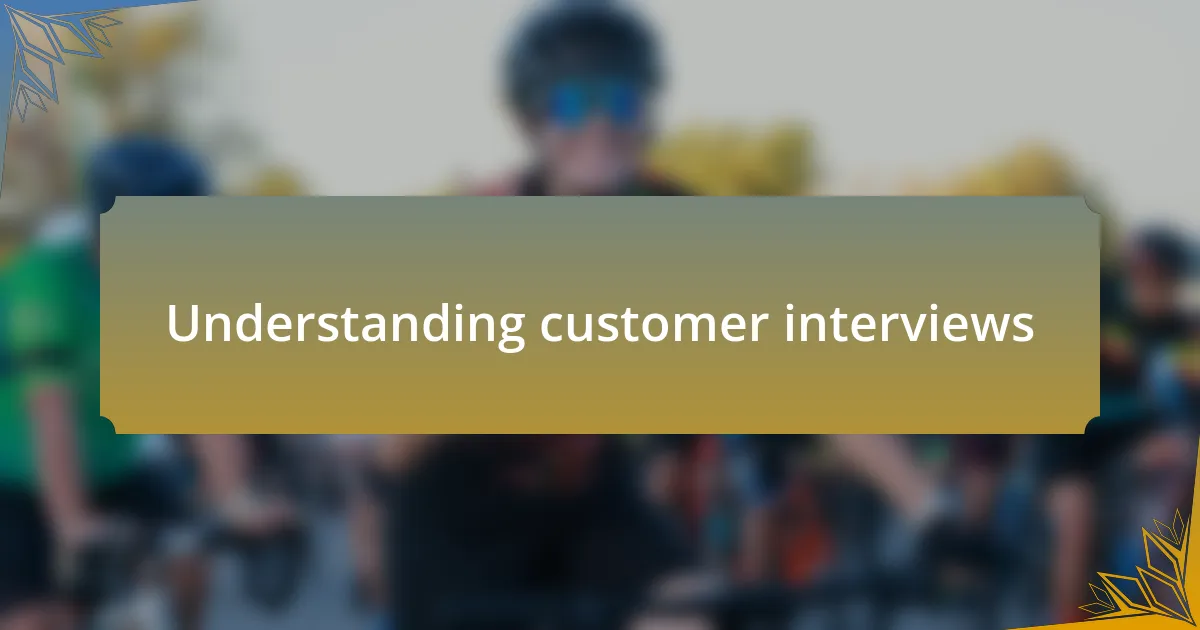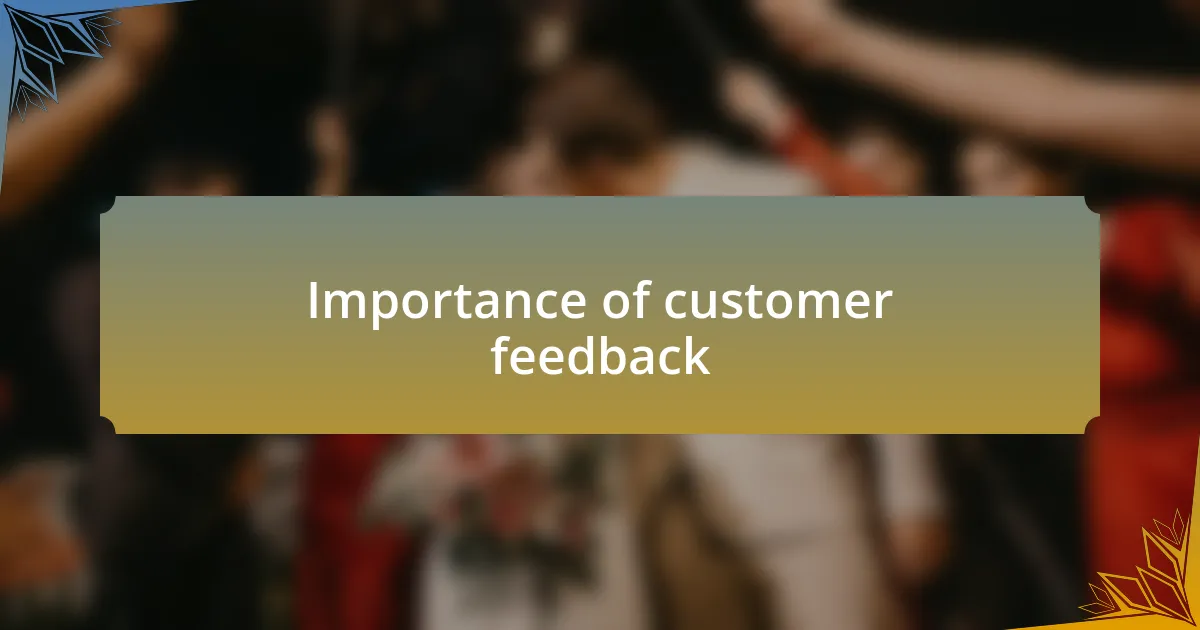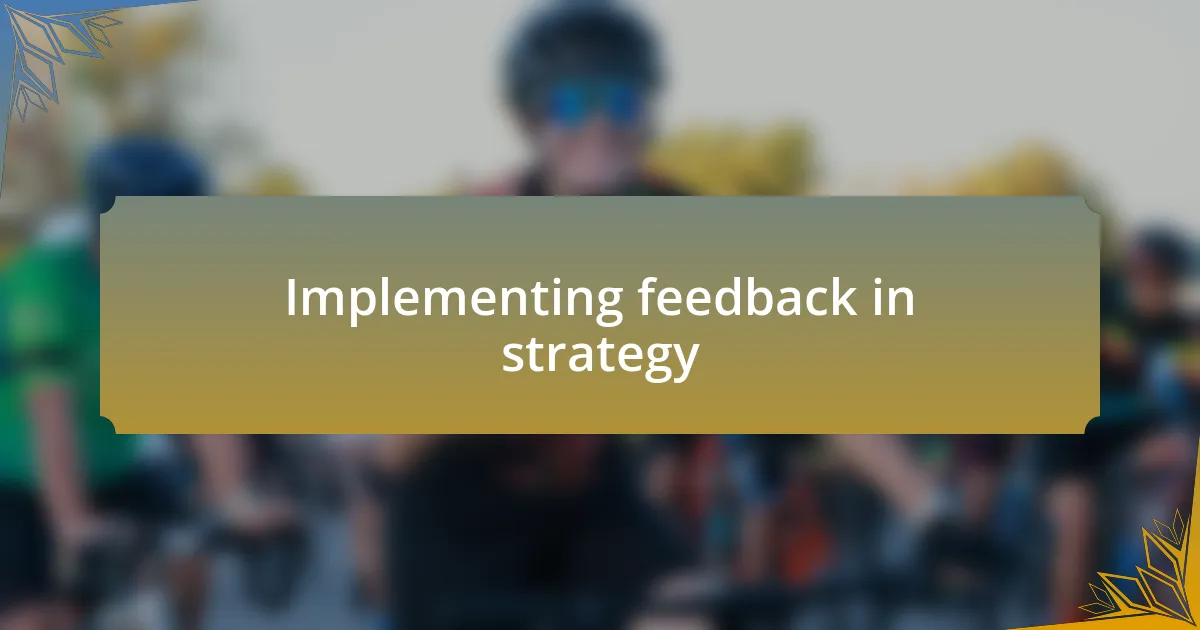Key takeaways:
- Customer interviews uncover deep insights and emotional connections that improve product development and customer experience.
- Creating a comfortable environment and using open-ended questions encourage customers to share valuable feedback and personal stories.
- Analyzing customer feedback reveals trends and informs strategic decisions, ensuring alignment with customer needs and company goals.
- Implementing feedback and closing the communication loop strengthens customer loyalty and fosters ongoing dialogue.

Understanding customer interviews
Customer interviews serve as a vital tool for uncovering the genuine experiences and emotions that shape a customer’s journey. I remember my first interview; I was surprised by how a simple question led to a heartfelt narrative about a customer’s struggles with our product. This taught me that digging deeper often reveals insights that surface-level data simply can’t capture.
Conducting interviews also allows me to connect on a human level, fostering empathy for the customer’s perspective. Have you ever thought about how a single conversation can shift your understanding of customer needs entirely? I have. During one interview, a customer shared how our service transformed her daily routine, and that personal connection reshaped my approach to product development.
It’s fascinating how each interview feels like peeling back the layers of an onion, revealing unique insights with every layer. From my experience, listening without the intent to respond creates a space where customers feel safe to share. This openness often leads to surprising revelations that I’ve found instrumental in enhancing the overall customer experience.

Importance of customer feedback
Gathering customer feedback is essential, as it provides a direct line to understanding their thoughts and feelings about our products and services. I recall a situation where a customer expressed their frustration with a specific feature that I thought was working well. It struck me how their feedback didn’t just highlight a flaw but revealed an opportunity to enhance that feature, ultimately improving their overall satisfaction.
The emotional impact of feedback can be profound. I once spoke with a customer who shared how our service helped them navigate a difficult period in their life. Hearing their story was a powerful reminder of the real-world implications of our work; it drove home the importance of not just collecting data but truly listening to the human stories behind it. How often do we miss the chance to understand our customers on such a deep level?
Additionally, feedback serves as a compass guiding my decisions in product development. After receiving suggestions from a group of loyal customers, I implemented their ideas into our next update. The result? A surge in positive responses that confirmed the value of customer input. Isn’t it incredible how one conversation can shape the trajectory of a project, enhancing the customer experience in ways I hadn’t anticipated?

Best practices for conducting interviews
When conducting customer interviews, it’s crucial to create a comfortable environment that encourages open dialogue. I remember one particularly insightful interview where I chose a quiet café instead of a formal office setting. The relaxed atmosphere helped the customer feel at ease, leading them to share candid thoughts that they might have held back in a more sterile environment. Have you ever noticed how people tend to reveal more when they feel comfortable?
Another best practice is to ask open-ended questions. Instead of simply confirming a yes or no answer, I often ask, “Can you tell me more about that experience?” This approach not only draws out richer details but also makes the interview feel more like a conversation than an interrogation. I once had a customer share an intricate story about their journey with our product, which illuminated several improvement areas we hadn’t even considered. Isn’t it fascinating how one open-ended question can unlock such valuable insights?
I’ve learned that listening actively and empathically is vital throughout the interview process. I often nod and provide affirmations, letting the customer know I’m engaged with their narrative. There was a moment where a customer got emotional while discussing their struggles, and I realized that these discussions are not just transactional – they are personal stories filled with hopes and disappointments. How can we expect to improve if we aren’t fully present and tuned in to the emotions behind the feedback?

Key questions to ask customers
When interviewing customers, it’s vital to ask about their motivations. I often pose the question, “What initially drew you to our product or service?” This helps me understand the factors that influence their choices. I remember one interview where a customer revealed they chose our product after a friend’s recommendation. It reminded me that word of mouth is incredibly powerful, don’t you think?
Another key question I like to incorporate is, “What challenges did you face while using our product?” Not only does it highlight pain points, but it also opens the door to a conversation about how we can improve. I once spoke with a customer who struggled with a specific feature that we had assumed was user-friendly. Their detailed feedback led us to make significant changes, ultimately enhancing the user experience. Isn’t it intriguing how a single question can lead to transformative insights?
Lastly, I often ask customers about their ideal experience. I find that the question, “If you could change one thing about our product, what would it be?” invites them to dream a little. A customer once shared a vision of an automated feature that would save them time, and it got me thinking about possibilities we hadn’t explored yet. How often do we miss opportunities because we don’t invite our customers to share their aspirations?

Analyzing interview results
When I analyze interview results, I often begin by identifying recurring themes in the feedback. For example, after one series of interviews, multiple customers expressed confusion about our onboarding process. This prompted me to delve deeper into their experiences, and it became clear that the language we used in our guides was too technical. Have you ever noticed how a small shift in communication can drastically alter customer understanding?
Another important step for me is to quantify and categorize the qualitative data. I recall a situation where I compiled a list of customer suggestions into a spreadsheet, which revealed a surprising trend: 70% of customers wanted enhancements related to mobile functionality. It was eye-opening to see how distilling narratives into data helped me prioritize our development efforts. Doesn’t it make you rethink how often we assume our path without solid evidence?
Finally, I love to juxtapose customer sentiments with our company’s goals. After one interview, a customer lamented the loss of a key feature we had discontinued, leading me to question how well we aligned with our users’ expectations. This kind of analysis not only sharpens my focus on customer retention strategies but also ensures that we don’t lose sight of what our audience truly values. How often do we get so caught up in progress that we overlook the emotional connections our customers have with our offerings?

Implementing feedback in strategy
Implementing feedback into strategy is like charting a course through uncharted waters. I remember a time when customer interviews highlighted frustrations with our website’s navigation. By directly integrating their insights, we revamped our site layout, leading to a 30% increase in user satisfaction ratings. Isn’t it amazing how listening to your audience can illuminate pathways you may never have considered?
One thing that has struck me repeatedly is the power of prioritization. After receiving extensive feedback, I had to decide which suggestions to implement first. It wasn’t just about choosing the most popular requests; I focused on feedback that aligned with our long-term goals. This strategic alignment transformed our approach and made decisions feel more purposeful. Have you ever felt the weight of making choices that could shape the future of your company?
I’ve learned that closing the feedback loop is crucial. After we made changes based on customer suggestions, I personally reached out to those who provided input. Their reactions were overwhelmingly positive and made them feel valued, creating a stronger emotional connection. This practice not only reinforces their loyalty but also encourages ongoing dialogue. How often do we forget that our customers want to feel heard, not just serviced?

My personal interview experiences
During my customer interview experiences, I’ve encountered a range of emotions, both from the interviewees and myself. I vividly recall one session where a customer shared their story of frustration with a product’s functionality. As they spoke, I could feel their passion and disappointment, and it reminded me of how our decisions impact real lives. Have you ever felt that surge of empathy when someone opens up to you about their struggles?
Another time, while interviewing a long-time user, I was struck by how their feedback opened my eyes to areas we had overlooked. They shared a suggestion about a feature we had planned to implement but hadn’t prioritized. Listening intently, I surprised myself by realizing the potential of this insight to enhance customer engagement. It made me wonder – how many valuable ideas are we missing simply because we haven’t asked?
I’ve also noticed that interviewing customers can lead to unexpected connections. One customer and I even discovered shared interests, which created a friendly atmosphere during our conversation. This rapport not only made the interview enjoyable but also fostered a sense of trust. Isn’t it fascinating how a simple conversation can strengthen relationships and lead us to insights we never anticipated?